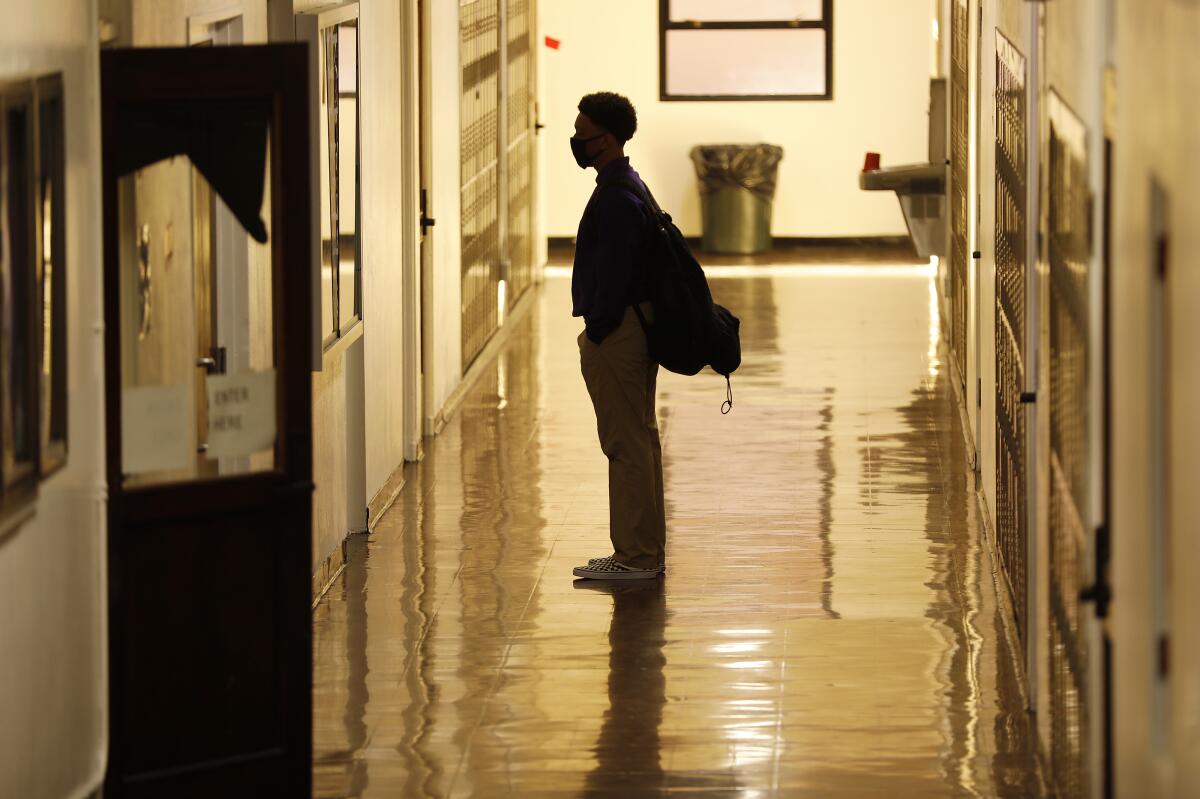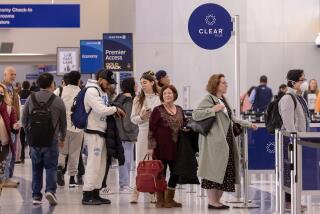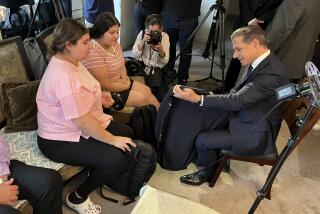Op-Ed: The school emailed about a COVID-19 ‘Case Cluster.’ Soon, I was cold-calling to help

- Share via
Perhaps it was the latest email from the high school administration, the one that had “Covid-19 Case Cluster” in the subject line. Or the stories my three nephews were coming home with. The 16-year-old described a situation in biology class where the student sitting behind him was wracked with a coughing fit so severe she had to leave the classroom, lurching and hacking.
The 11-year-old middle schooler posed a non-hypothetical question: If I share almost all my classes with a kid who is now quarantining, shouldn’t I be quarantining? This was after he told me there were 14 empty seats in one of his classes due to quarantine.
All of this occurred within the first two weeks of school in our district in the Bay Area. It felt like every other day we were receiving a “Positive Covid Case Community Letter” that attempted to reassure families “there is no reason to believe your student is a close contact,” meaning a coronavirus-positive child had not come within six feet of our student for a total of 15 minutes over a 24-hour period.
The words rang hollower with every subsequent email.
I was moved to cold-call the schools my nephews attended and offer to make my services available in any way that could help, since I’m a doctor in the community who has treated COVID-19 patients throughout the pandemic.
Our local high school does have a student health clinic, so my call was forwarded to a staff member there. I said I could make myself available however the school saw fit, including speaking with any student who may not be vaccinated but is open to speaking with a clinician one on one.
As the call was winding down, the staff member suddenly jumped in with a “while I have you on the phone, doctor, could I ask you a clinical question about a symptomatic student?”
The staff member appeared grateful and eager for the support. They are on their own. Teachers, administrators, parents. We thought this part was over, but here we are again.
As we have seen in Marin County, it only takes one unvaccinated teacher to infect half a class. After one middle school had a student test positive for the coronavirus, my friend who is the principal there told me she spent much of the last few weeks sticking labels on vials as they tested and retested the entire sixth-grade class. They were understaffed and the “COVID liaisons” who were supposed to be in place to help with testing had not been hired, so the principal stepped in. “I haven’t been trained in any of this,” she said. “I am just learning on the fly.”
When the younger kids were allowed back in school for a few fleeting and precious weeks of in-person learning in the spring, schools had a dry run to prepare them for this fall. Our then-fifth-grader was exposed to COVID in class. The response was botched from the outset.
Parents weren’t properly informed, and a student showed up to school the next day. Information on when to get tested by the next day was confusing, and there was outright misinformation on the handout in Spanish. So I asked my nephews an admittedly loaded question: What does it say about how our school district values Spanish-speaking families when the English handout is correct and the Spanish version isn’t? Two nephews answered in unison: “that their lives don’t matter.”
I told my 13-year-old nephew, another middle schooler, about the Army veteran from Texas who lived three houses down from an emergency room but died of gallstone pancreatitis because the beds were mostly filled with unvaccinated COVID patients. The man’s doctor, choking back tears, spoke of scrambling to locate a bed for his patient, the first he had ever lost to this treatable diagnosis. My nephew’s face contorted with anger as he exclaimed, “If these people don’t believe in science and vaccines, then why don’t they just stay home? Why do they come to hospitals after they get sick and all of a sudden believe in science?”
I didn’t have an answer, but his rage was my rage.
We want our kids to be healthy and stay in school, and one of the only ways we can ensure that happens is to continue masking, testing and insisting on universal vaccination for those who are eligible. Every unvaccinated person is a potential reservoir for a new strain that could do even more damage than the Delta variant. We clinicians are out here begging our patients to get vaccinated because none of us want to familiarize ourselves with the entire Greek alphabet over the next year.
I know teachers in Oakland who are still fighting for the most basic public health measures to be put in place, such as insisting that the free breakfast program doesn’t require students to be crammed indoors while unmasked and eating.
Neither of the schools I contacted has circled back to take me up on my offer of time and support, possibly because at any moment they are only one coronavirus test away from a potential health crisis. As record numbers of children continue to be hospitalized with COVID-19, we need to ensure our schools are as safe as possible for students to continue in-person learning. If my family’s experience is any indication, not nearly enough is being done right now.
Dipti S. Barot is a primary care doctor in the San Francisco Bay Area. @diptisbarot
More to Read
A cure for the common opinion
Get thought-provoking perspectives with our weekly newsletter.
You may occasionally receive promotional content from the Los Angeles Times.










